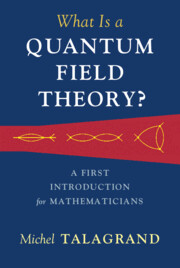Book contents
- Frontmatter
- Dedication
- Contents
- Introduction
- PART I Basics
- Part II Spin
- Part III Interactions
- 11 Perturbation Theory
- 12 Scattering, the Scattering Matrix and Cross-Sections
- 13 The Scattering Matrix in Perturbation Theory
- 14 Interacting Quantum Fields
- Part IV Renormalization
- Part V Complements
- Solutions to Selected Exercises
- Reading Suggestions
- References
- Index
13 - The Scattering Matrix in Perturbation Theory
from Part III - Interactions
Published online by Cambridge University Press: 22 February 2022
- Frontmatter
- Dedication
- Contents
- Introduction
- PART I Basics
- Part II Spin
- Part III Interactions
- 11 Perturbation Theory
- 12 Scattering, the Scattering Matrix and Cross-Sections
- 13 The Scattering Matrix in Perturbation Theory
- 14 Interacting Quantum Fields
- Part IV Renormalization
- Part V Complements
- Solutions to Selected Exercises
- Reading Suggestions
- References
- Index
Summary
In the first few sections we examine how we might define Hamiltonians which make physical sense, and we observe that the interaction picture, on which the entire approach is built, is fraught with mathematical inconsistencies. Nonetheless we proceed using it to compute the S-matrix in some of the simplest possible models. This is the heart of the theory. In a very progressive fashion we introduce the main tools, Wick’s theorem and the Feynman propagator, a very special tempered distribution. We then introduce Feynman’s diagrams. Each diagram encodes a term of a complicated calculation, and we give an algorithm to compute the value of such a diagram by a complicated integral. We pay great attention to clarify the nature and the role of the so-called symmetry factors. We then receive the bad news. As soon as the diagrams contain loops the integral giving its value has an irresistible tendency to diverge, a consequence of having attempted an ill-defined multiplication of distributions. We then show how to get a sensible physical prediction out of these infinite integrals, first in the relatively easy case of diagrams with one loop, and then in the much deeper case of diagrams with two loops, which involves a remarkable “cancellation of infinities”. We also introduce the physicist’s counter-term method to produce such cancellations.
Keywords
Information
- Type
- Chapter
- Information
- What Is a Quantum Field Theory? , pp. 351 - 419Publisher: Cambridge University PressPrint publication year: 2022
